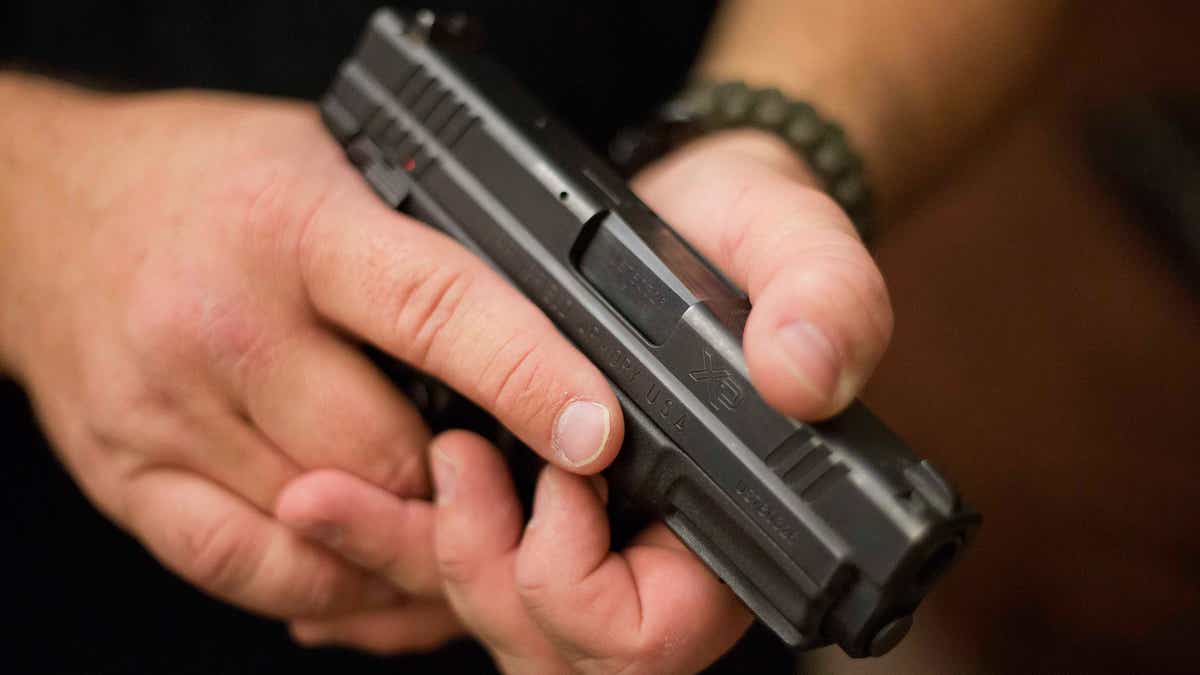
Phil Burns, a firearms instructor, holds a handgun that he carries as part of his survival supplies at his home in American Fork, Utah, Dec. 14, 2012. (REUTERS/Jim Urquhart)
Monday marks the 50th anniversary of the 1966 sniper shooting that left 14 dead at the University of Texas at Austin. The killer, a former marine, murdered his wife and mother before going to the UT campus and shootings his victims from the clock tower. On Monday, the school will unveil a new memorial to those who were killed. Also on Monday, Texas becomes the eleventh state to mandate that permitted concealed handguns be allowed on public university campuses (21 other states leave that decision up to the individual schools).
The coincidence of the dates was accidental, but many are outraged by what they consider the callousness of legislators marking this anniversary by allowing more guns on college campuses. Others, such as University of Texas at Austin President Greg Fenves, say that the two events “are separate issues. We are not connecting them in any way.”
But if America has learned anything from past mass public shootings, it is that August 1 is precisely the day to implement the new law. The only thing that is really outrageous is that it took 50 years to pass it.
Gun control advocates think that gun bans will make people safer. But banning guns only ensures that law-abiding good citizens are disarmed, not the killers. Instead of bans improving safety, these bans attract killers and make it easier for them to commit crimes. My new book, “The War on Guns,” shows that all mass public shootings in Europe have occurred in places where law-abiding citizens were prohibited from carrying guns. The same is true for over 98 percent of the attacks in the U.S.
Few people seem to know the actual history of the 1966 University of Texas attack. It occurred three decades before Texas allowed permitted concealed handguns anywhere in the state, let alone on college campuses. The University of Texas also forbade the carrying of guns on campus, except with special permission. When the attack started, though, many people retrieved their guns from their locked, off-campus cars.
How important were these armed citizens? Ramiro Martinez, one of two Austin police officers who shot and killed the UT gunman, explained in his 2005 autobiography, “They Call Me Ranger Ray”:
I was and am still upset that more recognition has not been given to the citizens who pulled out their hunting rifles and returned the sniper's fire. The City of Austin and the State of Texas should be forever thankful and grateful to them because of the many lives they saved that day. The sniper did a lot of damage when he could fire freely, but when the armed citizens began to return fire the sniper had to take cover. He had to shoot out of the rainspouts and that limited his targets. I am grateful to the citizens because they made my job easier.
Another civilian, Allen Crum, was loaned a gun by a police officer. He used it to join Martinez in storming the clock tower observation deck. Crum was able to draw the killer’s fire and make Martinez’s task significantly easier.
Others have gleaned a different lesson from this attack. Professor Pete Blair at Texas State University told USA Today last week: “The concern we have is that a concealed-carry person will be mistaken for an active shooter. It’s a high-stress situation and a lot of things are happening very quickly. There’s the potential to make a mistake.”
So much of the gun control debate involves mere hypotheticals. But instead of speculating, let’s look at the actual data. No permit holder has ever shot a bystander when stopping a mass public shootings (and there have been many dozens of such cases). Nor, in these cases, have the police ever accidentally shot a permit holder.
Over the decades, accidents have proven exceedingly rare. There have been five accidental discharges by teachers or staff — one at a K-12 school in Utah and one each at universities in Colorado, Idaho, Mississippi, and Utah. All of the cases involved very minor injuries. None involved non-permitted individuals getting a hold of the guns.
At colleges, fears are raised that substance abuse and gun abuse will go hand-in-hand. However, college-aged permit holders have been just as law-abiding as permit holders generally. That is to say, extremely law-abiding.
Despite the uproar about what might go wrong with allowing permitted concealed handguns, I predict that in a year from now these concerns will have subsided.
There is a reason that even the most ardent gun control advocate would never put “Gun-Free Zone” signs on his home. Let’s finally stop putting them elsewhere.
